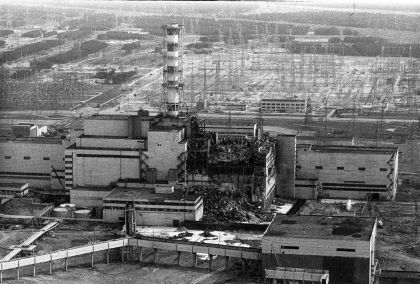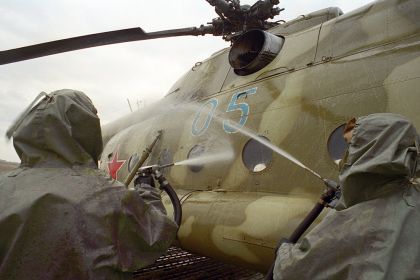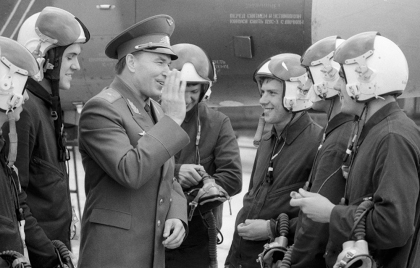Hero of the Soviet Union, Nikolai Antoshkin – the commander of the helicopter firefighting mission that extinguished the Chernobyl Nuclear Power Plant fire, died on January 17, 2021. He died of the coronavirus.
In Moscow, at the age of 78, General-Colonel Nikolai Antoshkin, Hero of the Soviet Union, passed away. Recently, he was in hospital and according to federal media reports, he was diagnosed with Covid-19.
Antoshkin’s military career began in 1965. He fought in several of his country’s wars, including the invasion of Czechoslovakia in 1968, the border war with China in 1969, and in Afghanistan in 1979, but the most dangerous war he fought was in Chernobyl with the invisible enemy – radiation.
On April 29, 1985, he was promoted to Major General of Aviation. A year later, Antoshkin faced the most important task in his life – to eliminate the consequences of the Chernobyl disaster.
General Antoshkin was the commander of the aviation group during the liquidation of the consequences of the accident at the Chernobyl NPP, where he had personally participated in flights over the destroyed power unit. As a result of many flights over the destroyed reactor, he received a huge dose of radiation.
The Role of General Antoshkin in the Chernobyl Disaster

Beginning of May 1986 . Photo of the Chernobyl Nuclear Power Plant shows the destruction from the explosion and fire of reactor No. 4 on April 26.
Photo: Igor Gavrilov
The No. 4 reactor at the Chernobyl Nuclear Power plant exploded on April 26, 1986, at 1:24 AM Kyiv time. At five in the morning, Major General Nikolai Antoshkin, at that time Chief of Staff of the Air Force of the Kyiv District, was awakened by a phone call off the duty officer: “You urgently need to go to Chernobyl, something happened there, you may need aviation assistance.”
He didn’t take anything with him. He thought he would be back in a day:
“When they reported what had happened and asked for help, I sent a helicopter for reconnaissance. After the first analysis I realized: it’s a terrible disaster. Aviation is indispensable there. I personally went there with the Air Chemical Officer of the district”.
The explosion occurred as a result of an experiment to study the possibility of generating electricity by the station’s generators in the event of an emergency power outage of the system. The experiment was poorly prepared and carried out with safety violations. After the explosion of the reactor, a fire started, which contributed to the dispersion of radioactive waste.

Location map of airfields and helipads involved during the liquidation of the consequences of the Chernobyl disaster.
On April 27, about 80 (according to other sources – 90) helicopters were concentrated in the Chernobyl NPP area. In the following days, personnel and equipment from other units were attracted, and in general, helicopter pilots from 46 units worked in the Chernobyl area.
Soviet air force and civilian helicopters from as far afield as Siberia, more than 3,000km away, were scrambled in an effort to seal the cracked reactor. Five Mil helicopter types were used for the clean-up operation: the Mi-2 (Hoplite), Mi-6 (Hook), Mi-8 (Hip), the combat Mi-24R (Hind) and the heavylift Mi-26 (Halo).
They were also used to provide liaison capabilities, for humanitarian missions and to drop supplies to the thousands of “liquidators” on the ground, assisting in the clean-up operation and preventing the fire and radiation from spreading

Helicopter pilots make radiation reconnaissance over the building of the Chernobyl NPP after the disaster.
Photo: Sputnik
During the day on April 27, the crews of several helicopters performed radiation reconnaissance flights, video and photographs of the destroyed reactor. However, the main efforts at the initial stage of eliminating the consequences of the accident were focused on reducing the release of radioactive products into the atmosphere.
On the first day, crews dropped sand through the open door of the helicopter, one sack at a time, but then technicians developed a way of using containers attached to small brake parachutes to make the job more effective. The new containers were dropped from a specially mounted quick-release mechanism from a height of 500 – 600 m. Up to eight sacks at a time were then able to be dropped from a net slung beneath the helicopter.
On the first day of operations, 96 missions were flown. On day two, this number had almost doubled, to 186. The Mi-26 can carry an internal or external maximum payload of 20,000 kg – but only about 2,000-3,000 kg could be dropped at a time. A full payload dropped from a safe hovering position would have further damaged the crippled reactor and run the risk of more leakage. The full crew on the first missions of two pilots, flight engineer and navigator was soon cut to two pilots and the flight engineer.
From April 26 to May 5, 1986, Antoshkin supervised the actions of the consolidated aviation group attached to the support units and subdivisions, and civilian brigades to close the damaged reactor from the air.
During this period, together with other liquidators General Antoshkin:
- developed a methodology for controlling and dropping 9325 cargos laden with sand and lead onto the reactor using parachutes – it’s 5,000 tons of various materials;
- improved the suspension systems of Mi-6 and Mi-26 helicopters and launched their production at factories in the cities of Chernobyl, Chernigov, and Kiev;
- provided several thousand sorties of aircraft and helicopters to drop materials;
- delivered personnel to the accident area, various instruments and devices to the area of the damaged reactor, and carried out visual photographic and radiation reconnaissance of the reactor and the area around it;
- organised more than 4 thousand flights in 10 days, moreover, about 3 thousand flights to one point – to the damaged reactor.
The first two weeks after the accident, when fragments of graphite rods were lying around the station, and the radiation level exceeded all possible maximums, it was Antoshkin who led the operation to close the reactor.

Nikolai Antoshkin in a helicopter above Chernobyl NPP, beginning of May, 1986.
Photo: Unknown
Nikolai made the first fly around the Chernobyl Nuclear Power Plant in a helicopter personally, since he wanted not only to perform a new and extremely dangerous task, but also to experience what it would be like for his pilots.
Liquidation

Helicopters Mi-6 take part in the liquidation of the consequences of the Chernobyl disaster.
Photo: Vitaly Ankov RIA Novosti
After the explosion of the reactor, a fire started, which contributed the spewing of the radiation into the atmosphere and threatening to emit much more as a fire raged in the open reactor core, spreading radioactive smoke. That’s why the first step was to stop the spread and decrease the level of radiation coming from the reactor:
“On the recommendation of scientists, the government commission made a decision: from above, close the reactor tightly with a protective layer of sand. But there was nowhere to approach the destroyed block, except from the air. Therefore, I was immediately given the task to start throwing sand into a burning crater with helicopters as soon as possible. But while the evacuation was going on, the aviation was banned. They were afraid that something unexpected would happen. Suddenly we begin to throw sand, new emissions will go – and all this “mud” will fall on people”.
Under Valery Legasov’s command, it was decided to fill the burning reactor with sand, lead, and dolomite clay, and then to dump boron carbide in large quantities from helicopters to act as a neutron absorber and prevent any renewed chain reaction.

Response work at Chernobyl NPP
Source: Igor Kostin / Sputnik
“The very first “throws” were made with the Mi-8. We worked like this: the helicopter hovered over the destroyed block, the side door opened, and a technician, tied with a safety belt, dropped 60-100-kilogram bags. He dropped 5-6 bags – covered in sweat. In a few seconds, he will receive 5-6 Roentgens”, – says the general.
Helicopters were allotted to do the task, however, the choppers struggled to stay in place at the height of 200 meters with up to 200-degrees heat emanating from the reactor. The flights exposed the pilots to contaminated smoke and beams of radiation emanating from the reactor:
“This is hard work: the temperature at the bottom is 120–180 ° C, the radiation level was so high that the DP-5 geiger counter there simply went off scale. At that time we only had instruments that could measure levels up to 500 roentgens. It was theoretically calculated that at the height of the passage, the radiation exposure was within 1000 roentgens, but in fact it was 3–3.5 times higher. At the epicenter, these levels generally reached 10,000–12,000 roentgens.
Filling up the reactor turned out to be more difficult than we thought. Invisible death surrounded us from all sides”.

Group of Mi-6 is delivering lead into Chernobyl Nuclear Power Plant zone from Borispol airport
Photo: Unknown
“Sealing” the reactor, the helicopter pilots dropped over 5,000 tons of different material on the reactor, including about 40 tons of boron compounds, 2,400 tons of lead, 1,800 tons of sand and clay, and 600 tons of dolomite, as well as sodium phosphate and polymer liquids (Bu93).
“On the first day, our helicopter pilots dropped, I think, 56 tons. It seemed like a pretty good result, but scientists and the whole commission was disappointed, saying that it’s just a drop in the ocean. It turns out that according to their calculations we must drop 5-6 thousand tons!”
Author’s note: The total radioactive contamination covered more than 200 thousand square kilometers. 70% of the infected territories were in Ukraine, Belarus and Russia.

Commander of the Mi-8T helicopter crew – Sergei Volodin, Chief of the Air Force Staff, Major General N. Antoshkin, pilot-navigator V. Bushkov and flight technician A. Pankov, Chernobyl, 1986.
Photo: Unknown
“The first four days of my stay at the Chernobyl Nuclear Power Plant I spent without sleep. Only on the fifth day I had a chance to have a little rest”.
On May 5, the crews carrying out radiation reconnaissance reported that the level of contamination when approaching the reactor at an altitude of 200 meters was in the range of 40-60 roentgens (at the beginning it was 3-3.5 thousand).
Only after the closure of the reactor, on May 6, by order of the commander of the Kiev military district, he left the contaminated region, transferring control to Major General of Aviation, Feoktistov:
“This is how I went on a business trip for a day or two, and spent 10 days there”.
During this period, he had already received enough radiation – a dose of about 605-608 roentgens. Moreover, he lost about 11 kilograms of weight.
“When I arrived in Kiev on May 6, I was immediately admitted to the hospital. I remember that I slept for more than a day without interruption. They began to give me vitamins, sleeping pills and nothing else”.
But General Antoshkin made it through. Despite his exposure, he went on to a three-decade career in the Russian Air Force, then served in Parliament with the governing United Russia party before contracting the virus late last year.

Soldiers in protective suits decontaminate helicopter, Chernobyl, 1986.
Photo: RIA Novosti
During the Chernobyl tragedy, Major General of Aviation N.T. Antoshkin considered one of his main tasks to take care of people, to preserve their health and thanks to him, there was a clear organization of work and management, timely decontamination of helicopters, dosimetric control and sanitization of personnel, the adoption of various additional measures to protect against radiation, all tasks were successfully solved.
After Chernobyl

Nikolai Antoshkin with pilots.
Photo: Unknown
On December 24, 1986, Major General of Aviation Nikolai Timofeevich Antoshkin was awarded the title of Hero of the Soviet Union with the Order of Lenin and the Gold Star medal. He became the only Hero of the Soviet Union in the Air Force to receive this rank as Chief of Staff of the Air Force of Kyiv District:
“For the great personal contribution to the successful completion of the work on the elimination of the accident at the Chernobyl Nuclear Power Plant, the elimination of its consequences and the courage and heroism shown at the same time”.
Deputy Chairman of the Council of Ministers of the USSR, Boris Shcherbina initiated the decision of the government commission, in which the work of the aviators and personally of General N.T. Antoshkina:
“We were lucky that such a young energetic general was at the head of the aviation group during the Chernobyl accident!”
After that, Nikolai Timofeevich carried out about 20 more various tasks of the governments of the USSR and the Ukrainian SSR, the military command in the area of the destroyed reactor, settlements under construction for resettled residents and the city of Slavutich for power engineers, participated in organizing the actions of helicopter pilots to rescue fishermen in the Azov and artificial seas on the territory Ukraine.

General and former pilot Nikolai Antoshkin.
Photo: Unknown
After the accident at the Chernobyl Nuclear Power Plant, General Antoshkin continued to serve in various positions. In August 1988, Nikolai Timofeevich was appointed commander of the Air Force of the Central Asian Military District.
In September 1998, Colonel-General Antoshkin resigned from the post of Deputy Commander-in-Chief of the Air Force for combat training, head of the Air Force Combat Training Directorate. On September 18, 2016, he was elected to the State Duma of the Russian Federation of the VII convocation.
Nikolai Antoshkin died on January 17, 2021 at the age of 78 from coronavirus. COVID-19 gave severe complications, Antoshkin received a cerebral edema, which led to a coma.
The legendary Colonel General had been fighting the virus for a long time. The disease was debilitating. The wife of Nikolai Timofeevich was very much concerned about his well-being during the last days of her husband’s life, as the situation was slowly but surely deteriorating.

Nikolai Antoshkin.
Photo: phalera.ru – Ilya Grinberg
“A wonderful person has passed away, whose contribution to the development of the defense capability of our state can hardly be overestimated. He went through a difficult life path. He had many trials, which he always accepted with dignity.
Hero of the Soviet Union Nikolai Timofeevich Antoshkin devoted himself to military affairs, serving the Fatherland. He was a professional of the highest class, principled and strong-willed, courageous, strong-willed man”, – General Shamanov, the Chairman of the Defense Committee of the State Duma of the Russian Federation.
On January 20, 2021, Nikolai Antoshkin was buried with military honors at the Federal Military Memorial Cemetery of the Russian Defense Ministry.
We cherish the memory of Nikolai Antoshkin. We express our condolences to the family and friends of this hero.
Radioactively yours ChernobylX.



 ChernobylX
ChernobylX
 ChernobylX
ChernobylX